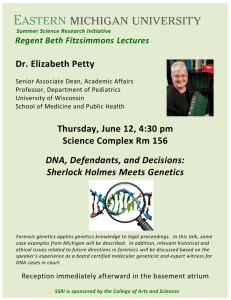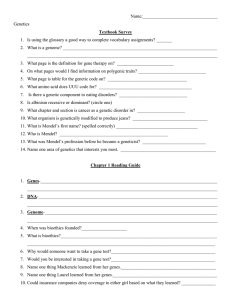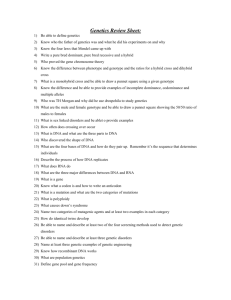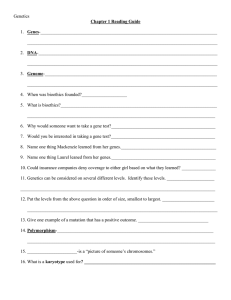Solapur University, Solapur M.Sc.- Genetics (Semester pattern)
advertisement
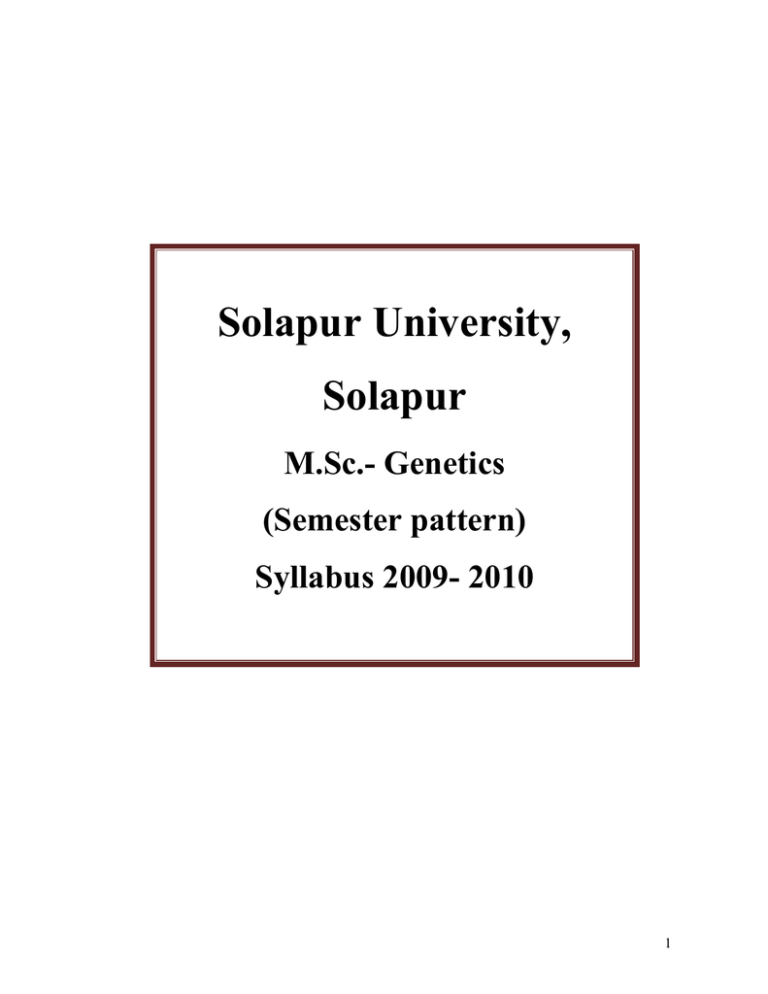
Solapur University, Solapur M.Sc.- Genetics (Semester pattern) Syllabus 2009- 2010 1 SOLAPUR UNIVERSITY, SOLAPUR M.Sc. GENITICS SYLLABUS SEMESTER PATTERN Candidates who have passed (a) 10+2 with Science and (b) Bachelor's degree in Science / Engineering /Technology/ Agriculture / Medicine / Veterinary Science / Pharmaceutics from recognized University and as per the eligibility criteria lay down by Solapur University; Solapur will be eligible for admission to M.Sc. course in GENETICS. Admission will be on the basis of Entrance examination conducted by Solapur University, Solapur. The course will be of two years duration and shall be completed in four semesters. SOLAPUR UNIVERSITY, SOLAPUR Syllabus for M.Sc. – I (Genetics) Semester – I Theory Papers: Paper -Gen101 Paper - Gen 102 Paper - Gen 103 Paper - Gen 104 : Concepts of Genetics : Biostatistics and Population genetics : Cytogenetics and Genome Organization : Molecular Biology 100 100 100 100 Practical Papers: Paper-Pr Gen101: Concepts of Genetics, Biostatistics and Population genetics. Paper- Pr Gen102: Cytogenetics and Molecular Genetics. 100 100 Semester – II Theory Papers: Paper- Gen 201: Regulation of gene expression and developmental genetics. Paper- Gen 202: Concept of Biochemistry Paper- Gen 203: Advanced microbial genetics Paper- Gen 204: Plant breeding, tissue culture & biotechnology 100 100 100 100 Practical Papers: Paper- Pr Gen201: Gene expression, Developmental genetics and Biochemistry Paper- Pr Gen202: Microbial genetics and Plant tissue culture 100 100 2 SOLAPUR UNIVERSITY, SOLAPUR Syllabus for M.Sc. – I (Genetics) Semester - I Paper - Gen 101 : Concepts of Genetics Total lecturers: 45 Section I Concepts of Genetics I. History of Genetics: Role of Breeding systems, life cycles of some genetically useful organisms such as viruses, bacteria, Neurospora, Drosophila, maize and Homo sapiens II. Mendelian genetics- Mendel’s laws of inheritance; Expression and interaction of genes, allelic and no allelic interaction; Multiple alleles, pseudo alleles, Complex loci, complementation. III. Linkage, crossing –over and chromosome mapping at genetic level. IV. Gene mapping in bacteria and viruses, fine-structure mapping. Genetic analysis in fungi, tetrad analysis, gene conversion. V. Qualitative and quantitative traits, polygenic inheritance; Sex-linked inheritance. Section II Concepts of Genetics I. Genetic variation – History, Categories of mutations, Genome, chromosome and gene mutations. II. Somatic mutations, extra chromosomal mutations, origin and frequency of spontaneous mutations. III. Mutator genes, introductory mobile genetic elements, Chromosomal alterations and evolution. IV. Induced mutations, Physical and chemical mutagens. 3 SOLAPUR UNIVERSITY, SOLAPUR Syllabus for M.Sc. – I (Genetics) Semester – I Paper- Gen 102: BIOSTATISTICS AND POPULATION GENETICS Total Lecturers: 45 Section I BIOSTATISTICS I. Principles and applications of statistical methods in biological research. II. Basic statistics- Samples and populations, experimental design, Data analysis, Graphs, Average, Coefficient distributions IV Chi-square, binomial, Poisson and normal. V Tests of statistical significance, Regression and correlation, Analysis of variance; Basics of computer application-Introduction to structural organization and types of digital computers, operating systems, Word processing. Section II POPULATION GENETICS I. History. II. Genetics polymorphism. Panmictic & Mendelian population, Hardy-Weinberg genetic Equilibrium. III. Causes of changes in gene frequency (migration, selection, genetic shift, inbreeding and mutations). IV. Natural and artificial selection, Heritability, Genetic load, Fisher’s fundamental theorem, V. Co adapted gene complex, Super genes, Linkage disequilibrium, and Genetic distance. VI. Molecular genetic analysis of populations, Mechanisms of speciation and evolution and speciation. 4 Paper - Gen 103: CYTOGENETICS AND GENOME ORGANIZATION Total lecturers: 45 Section I CYTOGENETICS I. Chromosome structure, organization: Chromatin structure, nucleosomal and higher order structures, morphology and basic functions. II. Mitotic and meiotic chromosomes, banding, karyo typing, chromosome labeling and cell cycle analysis, III. In situ hybridization, chromosome painting, gene mapping, somatic cell hybrids, premature chromosome condensation. IV. Special types of chromosome-sex chromosomes, sex chromatin, B-chromosome, Polytene and lamp-brush chromosomes. V. Maternal inheritance - Mitochondrial and Chloroplast, Pila, Drosophila-P-element. Section-II GENOME ORGANIZATION I. Numerical and structural changes in the chromosome. II. Mechanisms of sex determination in plants, animals and Drosophila (Dosage compensation). III. Genome organization in viruses, prokaryotes and eukaryotes (animals and plants). IV. Organization of Extrachromosomal genomes; cot curve. V. Genome mapping and functional genomics; Repetitive DNA-satellite (minisatellite, microsatellite DNA). VI. Transposable Elements, LINES, SINES, Alu family, mechanisms of DNA amplification, genome evolution; Fine structure of gene, split genes. Genes and multigene families. VII. DNA as genetic material; structure of DNA (B, Z, D). 5 Paper - Gen 104: Molecular Biology Total lecturers: 45 Section I GENE FUNCTION I. DNA replication in prokaryotes and eukaryotes at genetic level. II. Eukaryotic transcription: General principles, assembly of the basic transcription apparatus, III. Types of RNA polymerases, controls at initialization, elongation and termination. IV. RNA processing: processing of mRNA, capping and 3’ end formation splicing, polyadenylation, RNA editing, mRNA stability, termination of RNA synthesized by RNA Pol I and RNA Pol III. Section –II I. Genetic code, deciphering the code, codon usage. II. Protein synthesis: structure of ribosome, role of tRNA and Rrna. III Translation and its control, post translational modification advanced iutins & exins. IV. Protein trafficking. 6 Practicals for M.Sc. – I (Genetics) Semester – I Practical Paper – 105 Concepts of Genetics 1. Study of mitosis 2. Study of meiosis. 3. Orcein and feulgen staining of salivary gland chromosome of drosophila/ chironomas. 4. G-banding and karyotyping 5. Meiosis of complex translocation heterozytes. 6. Meiotic analysis in plants (stages, chaisma, chaisma terminalization by using photographs) pachytene analysis. 7. Study of B chromosome in Maize/Drimia. 8. To Study the effect of mutagens on germination, seedling growth and on mitosis. 9. Mendelism problem: one factor & two factor (one example each). 10. Spontaneous mutation: A-Fluctuation test – StrR. B-Replica plate method-StrR Biostatistics and Population genetics 1. Study of sampling methods (any one) 2. Study of data presentation (any one method) 3. Study of measures of central tendency. 4. Study of measures of dispersion or spread. 5. Study of probability. 6. Pedigree analysis (theoretical problems at least five) 7 Semester – I Practical Paper – 106 CYTOGENETICS 1. To Study Genome organisaton in Viruses & Prokaryotes. 2. Preparation of Drosophila polytene Chromosomes (temporary and permanent preparations) 3. Drosophila genetic crosses 4. Chromosome preparation from mouse bone marrow and human blood lymphocytes 5. Identification of inactivated X chromosome as Barr body and drumstick 6. To Study of Lamp-brush, B-Chrosome & Sex-Chrosome. 7. EcoR I digestion of total DNA Molecular Genetics 1. Transfer of digested DNA and probing with a labeled gene probe 2. To Study The Analysis of DNA /RNA: 1. Isolation of total DNA /RNA 2. Quantitation of DNA /RNA by spectrophotometer 3. Size fractionation of total DNA /RNA 4. Northern blot using rRNA specific PCR amplified DNA probe 3. Isolation of Mitochondria. 4. Isolation of Rifampicin resistant mutant (transcription). 5. Isolation of total RNA from bakers yeast (transcription). 6. Isolation of total proteins from E. coli and bakers yeast (translation). 7. Isolation of nuclei from bakers yeast. 8 Syllabus for M.Sc. – I (Genetics) Semester – II Paper- Gen 201: REGULATION OF GENE EXPRESSION AND DEVELOPMENTAL GENETICS Total lecturers: 45 Section I Gene Regulation & Expression: I. Gene regulation in prokaryotes: Operon model of regulation (with examples of lac, trp and ara). Negative, positive and attenuation control in bacteria. II. Lytic and lysogenic switch in lambda- antitermination. III. Gene regulation in eukaryotes: overview of gene regulation in animals and plants using examples of galactose-utilization in yeast; heat shock gene expression; Signal integration in Human β-Interferon gene. IV. DNA protein interaction - Activators V. Regulation of SV40 and CaMV 35S viral promoters. VI. Hormonal control of gene regulation in animals and plants. Regulation of Cell cycle, signal transduction. VII. Global influences on gene expression: chromatin conformation and methylation; Section II Developmental Genetics I. Molecular genetics of development. II. Introduction to developmental biology- Zygote development and differentiation in animals and plants. III. Model systems to study pattern formation- Dictyostelium: Life cycle, aggregation and slug formation, mechanism of cell differentiation in the slug and final body formation. Caenorhabditis elegans: cell lineage and mosaic development; vulval cell formation. IV. Drosophila: Polarity determination of embryo by maternal genes, segmentation genes and formation of body segments. V. Homeotic genes specifying segment identity; Vertebrate limb: specification of axis and limb field, zone of polarizing activity and digit formation, hoax genes and limb pattern, regeneration. VI. Arabidopsis: Life cycle, Embryogenesis and seed development, genes involved in flower development 9 Paper- Gen 202: Concepts of Biochemistry Total lectures: 45 Section I I. The living vs. the non-living state: Lehninger’s thesis of “molecular logic” of life. II. Introduction to bio-molecules: Classification of amino acids. Peptides, The primary, secondary and tertiary and quaternary structure of proteins. Proteins as informational macromolecules. III. Enzymes as biocatalysts; enzyme classification, Properties of enzymes, Active site. Mechanism of enzyme action; inhibition of enzymes, Biotechnological applications of Enzymes. IV. Laws of Thermodynamics: thermodynamics of cellular reactions, Redox potential, ATP as energy-rich compound. Section II I. Cellular metabolism: energy-yielding and energy-requiring processes; ;. Metabolic cycles it’s significance, energy production and enzymatic regulation of following pathways- Embeden Meyerhof Paranas pathway, TCA cycle , HMP shunt; Gluconeogenesis. II. Mitochondrial respiration: Electron transport chain, oxidative phosphorylation- the chemo osmotic theory. Structure of ATPase. III. Photosynthesis: Structure of Chloroplast, Photophosphorylation, Calvin Cycle, HSK Pathway. IV. Lipid metabolism: biosynthesis of fatty acids, Beta oxidation of fatty acid and it’s energetic. 10 Paper- Gen 203: ADVANCED MICROBIAL GENETICS Total lecturers: 45 Section I I. Methods of genetic analysis: Genetic analysis of mutants: recombination and genetic mapping. Test of allelism. II. Methods of gene transfer in bacteria- Conjugation: Discovery, nature of donor strains and compatibility, interrupted mating and temporal mapping, Hfr, F', hetero duplex analysis, mechanism of chromosome transfer, molecular pathway of recombination. III. Transformation: natural transformation systems, Biology of transformation, transformation and gene mapping, genetic complementation. IV. Transduction: discovery, generalized and specialized or restricted transduction, Phage P1 and P22-mediated transduction, mechanism of generalized transduction, abortive transduction, temperature phage lambda and mechanism of specialized transduction, gene mapping, finestructure mapping. Section- II I. Bacterial mutagenesis: mutation, evidence of spontaneous nature of mutation, Fluctuation test, Methods of isolation of autotrophic mutants, drug resistant mutants and phage resistant mutants, analysis of mutation in biochemical pathways. II. Plasmids: Types, detection of plasmid, purification of plasmid DNA, transfer of plasmid DNA, plasmid replication, partitioning, copy-number control, Properties of some known plasmids-Ti, R factor, Col plasmid, F plasmid, broad host range plasmid, Artificial plasmids & their significance in Genetic Engineering . III. Transposable elements: Terminology, Insertion sequences, detection of transposition in bacteria, types of bacterial transposons, transposition: Structure of transposon and target sites, replicative and non-replicative transposition, excision of transposons, Genetic phenomenon mediated by transposons in bacteria, concept of retroposons. 11 Paper- Gen 204: PLANT BREEDING, TISSUE CULTURE AND Total lecturers: 45 BIOTECHNOLOGY Section-I Plant breedingI. History; Genetic resources- centers of diversity and origin of crop plants, Law of Homologous variation, genetic resources. II. Plant breeding, Mode of reproduction and breeding strategies, Plant diseases and pests and defensive mechanisms. III. Breeding of self and cross pollinated and vegetatively propagated crop plants, Heterosis breeding, Polyploidy and haploids in breeding, Wide hybridization. IV. Mutation breeding, breeding crops to contain useful and adaptive traits; seed production and variety development and its conservation. V. Marker assisted breeding using molecular probes. Section-II Tissue culture and Biotechnology I. Plant tissue culture and somatic cell genetics – role of growth regulators & Micropropagation. II. Artificial seeds, Germplasm storage in vitro; Embryo rescue, Haploids and triploids, Secondary products. III. Protoplast culture and fusion, Cybrids, Somaclonal variation, Mutant selection in vitro and by transposon tagging. IV. Plant genetic engineering using recombinant DNA techniques, T-DNA and viral genomederived plant vectors, Transformation using plant protoplasts, Particle gun-mediated transformation, Organelle transformation. V. Engineering of crops for useful agronomic traits and metabolic pathways, Transgene Silencing, Strategies to avoid gene silencing and improve gene expression in transgenic plants. VI. Description and uses of antisence RNA, ribozymes in plants; Ethics and plant genetic engineering. 12 Practical Papers: Practical for M.Sc. – I (Genetics) Semester – II Total lecturers: 45 Gene expression, Developmental genetics 1. Isolation and quantification of proteins. Practical Paper-205 2. Study of heat shock proteins. 3. Observation of homeotic mutants of Drosophila 4. Study of Chick embryo development (preparation of whole mounts & permanent slides) 5. Study of mouse embryonic development (observation of embryos) 6. Study of museum specimens of abnormal fetuses in local medical colleges 7. Preparation of Drosophila polytene Chromosomes (temporary and permanent preparations) 8. Drosophila genetic crosses Biochemistry 1. Detection of Amino acids by TLC method. 2. Detection of Amino acids by paper chromatography. 3. Estimation of protein concentration by Biuret method. 4. Estimation of glucose concentration by glucose oxidase method. 5. Estimation of starch from potato. 6. Study of B-galactosidase 7. Detection and estimation of reducing sugar by DNSA. 8. Qualitative test for carbohydrate determination 9. Estimation of acid value. 10. Isolation casein from milk. 13 Practical Paper-206 Microbial genetics 1. Isolation of root nodule bacteria (Rhizobium). 2. Seed dressing and inoculation with Rhizobia. 3. Production of alcohol by microbes 4. Estimation of alcohol. 5. Study of bacterial transduction. 6. Detection and estimation of protease inhibitors from pulse seeds. 7. Production of citric acid from Aspergillus nigar . 8. Isolation of vitamin B12 auxotroph. 9. Isolation and quantification of genomic DNA from bacteria. 10. Isolation of Plasmid DNA from bacteria. Plant tissue culture 1. Induction of polyploidy using colchicines. 2. Cytological analysis of polyploidy plants 3. Study of Pollen fertility. 4. Isolation of genomic DNA from Plants. 5. Isolation of Ti Plasmid from Agrobacterium. 6. Media preparation, sterilization and callus culture. 7. Somatic embryogenesis and somaclonal variation, micro-propagation. 8. Cell suspension culture. 9. Isolation of protoplast by chemical and mechanical methods. 10. Synthetic seeds preparation. 11. Visit to commercial R & D green houses, agro based industries. 14
